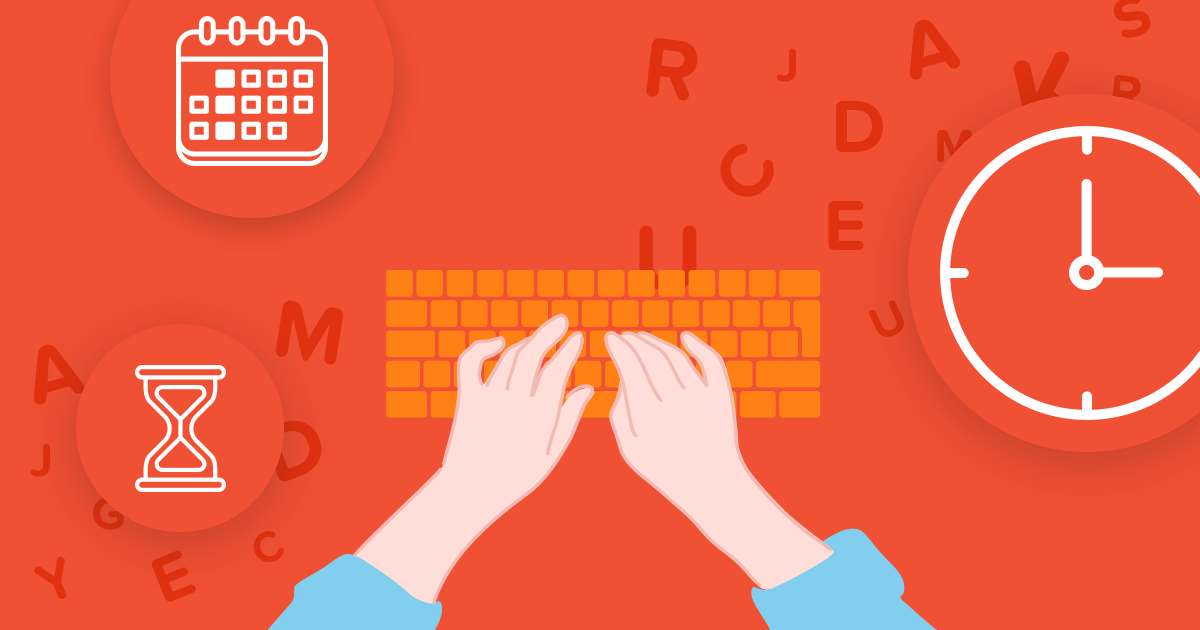
Learning to type, like any new skill, takes time. But just how much time, you ask? A few hours? A few years? Unsurprisingly, the answer differs from person to person and depends on a variety of factors. The good news is that practically anyone can learn to touch type. Read on to find out what influences how much time you need to become a touch-typing master and to get tips on how to develop your skills faster.
What affects how long it takes to learn touch typing?
Factors that impact the learner’s methods, motivations and individual circumstances will influence the speed at which that person will be able to pick up touch typing. These factors largely fall into four main categories:
Inherent abilities and experience
-
Age
Children generally pick up new skills more quickly than adults because their brains are primed for learning. That said, they’re limited to some extent by their still-developing bodies and minds, and they often lack the discipline needed to train effectively on their own. -
Disabilities
Disorders related to language and visual processing, like dyslexia, will affect the time it takes for someone to learn to type, since they influence how the text is processed mentally before the keys are pressed. -
Typing experience
People who’ve never learned to type have a distinct advantage—no need to break bad habits! Those who’ve picked up typing intuitively without formal training, however, will need time to unlearn old keystrokes and build new muscle memory.
Language
-
Keyboard layout
Keyboard types vary from region to region, and many specialized layouts have been developed to better accommodate the use of accented characters in different languages. Not all keyboards will have accurate key labelling depending on the chosen layout, however. Even more reason to learn touch typing—you won’t need to look at the keys anymore! -
Accented characters
People working in English don’t need to worry about accents, but those learning to type in most other European languages may find themselves having to memorize combinations of up to five keys to produce accented letters. -
Writing system
Surprisingly, languages like Mandarin that use symbolic characters to represent whole words are some of the fastest to learn to type. With the popular pinyin input method, typists often need only enter the first letter of each Chinese character's phonetic spelling, making it possible to write whole sentences with just a few keystrokes.
Learning objectives
- Initial skill level and speed goals
Complete beginners may reach a respectable typing speed very quickly, but the time it takes to improve further increases with the learner’s ability. Boosting your speed from 60 WPM to 90 WPM, for example, could easily take twice as long as going from 15 WPM to 45 WPM. If you feel the need for speed, it helps to know where the start and finish lines are before you begin! Find out where you stand by reading our article on typing speed and trying out Typing Pal’s free test.
Training approach
-
Duration
Long practice sessions can cause boredom and burnout, and they yield diminishing returns on your time investment. If you find training a chore, you’ll be less likely to do it and be less engaged in learning when you are doing it! -
Frequency
The more you train, the more your skills will improve, but you need to balance session frequency with duration. You’ll learn faster if you plan frequent, short training sessions than if you only do the occasional “binge-training”. -
Commitment
Until you fully develop muscle memory specific to touch typing, your brain will intuitively revert to old habits and stall your progress. Your newly acquired abilities will also diminish over time without deliberate practice.
What will speed up touch-typing training?
The most efficient way to learn touch typing is to choose a training program like Typing Pal that teaches you proper finger positioning and measures your speed, accuracy and progress. Despite the many factors that influence the time it takes to learn, you’re sure to reach your goals quickly if you follow these three time-tested tips:
- Focus on accuracy, and your speed will improve naturally as the correct finger movements become ingrained in muscle memory through repetition.
- Train in short 15- to 20-minute sessions for a minimum of one hour per week to maximize your progress.
- Practise regularly for several weeks even after you’ve reached your speed goal to lock in your new skills so you won’t need to start over.
So, just how long does it take to learn to type? There’s no one good answer, but if you’re really itching for a hard-and-fast figure, consider the 100-Hour Rule: it only takes about one hundred hours of deliberate practice to go from zero skill to a level better than 95% of the population. If you divide those hours up into short 20-minute practice sessions every day, you’ll unlock your potential to become a tip-top typist in under a year! It’s no coincidence that we offer a yearly subscription plan. Why not sign up for the free trial? You’ll see for yourself how Typing Pal can help you train at your own pace.



